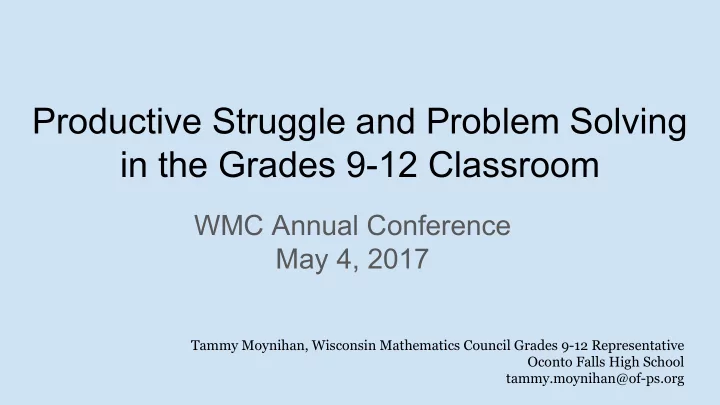

Productive Struggle and Problem Solving in the Grades 9-12 Classroom WMC Annual Conference May 4, 2017 Tammy Moynihan, Wisconsin Mathematics Council Grades 9-12 Representative Oconto Falls High School tammy.moynihan@of-ps.org
Introduce yourself to your neighbor Where are you from? What do you teach?
Cup Stacking Challenge
Agenda 1. Define productive struggle. 2. A supportive classroom environment: a. Growth Mindset/Mistakes b. Teamwork/Collaboration c. Engaging Tasks 3. Tasks to support productive struggle a. Building a New Playground Task b. Productive Struggle Video Clip 4. Questioning
What does productive struggle look like in the classroom? What doesn’t it look like? Turn and talk.
Definition of Productive Struggle Productive struggle refer to a student’s ‘‘effort to make sense of mathematics, to figure something out that is not immediately apparent’’ (Hiebert & Grouws 2007, p.287; Robert Q. Berry, III, Ph.D. MPES Presentation!)
Support productive struggle in learning mathematics. Effective teaching of mathematics consistently provides students, individually and collectively, with opportunities and supports to engage in productive struggle as they grapple with mathematical ideas and relationships. (NCTM, 2014)
Teachers must create a classroom culture that demonstrates “struggle as a natural part of the learning process” (Star, 2015) and allows students to see the potential in persevering.
Mindset Monday!
Growth Mindset & Struggle When my students make mistakes in math they believe they are not good at math. 1 2 3 4 5 Agree Somewhat agree Not Sure Somewhat Disagree Disagree
How Can We Change the Ways Students View Mistakes? EMBRACE MISTAKES! CELEBRATE MISTAKES!
My Favorite No What message(s) does this activity send to students?
Algebra 1 Examples
What are teachers doing? What are students doing? • Anticipating what students might struggle with • Struggling at times with mathematics tasks but during a lesson and being prepared to support knowing that breakthroughs often emerge from them productively through the struggle. confusion and struggle. • Giving students time to struggle with tasks, and • Asking questions that are related to the sources of asking questions that scaffold students’ thinking their struggles and will help them make progress without stepping in to do the work for them. in understanding and solving tasks. • Helping students realize that confusion and errors • Persevering in solving problems and realizing are a natural part of learning, by facilitating that is acceptable to say, “I don’t know how to discussions on mistakes, misconceptions, and proceed here,” but it is not acceptable to give up. struggles. • Helping one another without telling their • Praising students for their efforts in making sense classmates what the answer is or how to solve the of mathematical ideas and perseverance in problem. reasoning through problems. Principles to Actions. NCTM, 2014
Collaboration
Engaging Tasks
Engaging Tasks
BUILDING A NEW PLAYGROUND (Part A only) The City Planning Commission is considering building a new playground. They would like the playground to be equidistant from the two elementary schools, represented by points A and B in the coordinate grid that is shown. PART A 1. Determine at least three possible locations for the park that are equidistant from points A and B. Explain how you know that all three possible locations are equidistant from the elementary schools. 2. Make a conjecture about the location of all points that are equidistant from A and B. Prove this conjecture. (Principles to Actions Toolkit: http://www.nctm.org/)
1. Work on task individually. 2. Share solution(s) with elbow partner. 3. Share with smaller groups. a. How would students solve this problem? b. Any student misconceptions you can anticipate? c. How might you implement this task in a classroom? Proximity Partners: 2 chairs, 1 table, 1 corner of the room
Supporting Productive Struggle: Video Clip Redefining Student and Teacher Success handout Take a moment to read several of the boxes... As you watch the video, how does the teacher support student learning and engagement in the classroom? Be prepared to share - citing line numbers will help!
Supporting Productive Struggle: Video Clip Evidence of growth mindset? Evidence of collaboration? Evidence of an engaging task?
Pose purposeful questions. Effective teaching of mathematics uses purposeful questions to assess and advance students’ reasoning and sense making about important mathematical ideas and relationships. (NCTM, 2014) Looking back at the transcript, identify Purposeful Questions . Be ready to share!
Question Type Description Gathering Information Students recall facts, definitions, or procedures Probing Thinking Students explain, elaborate, or clarify their thinking, including articulating the steps in a solution methods or the completion of a task. Making the Math Visible Students discuss mathematical structures and make connections among mathematical ideas and relationships Encouraging reflection and Students reveal deeper understanding justification of their reasoning and actions, including making an argument for the validity of their work.
Link to Handout
How might you apply what you’ve learned today to your classroom?
Tammy Moynihan tammy.moynihan@of-ps.org
Recommend
More recommend